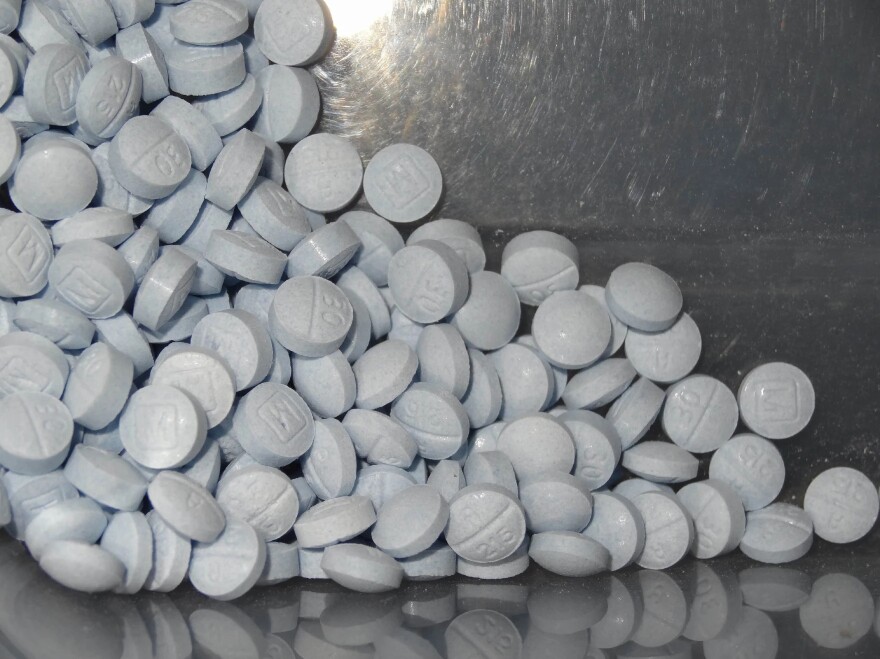A group of scientists, including a University of Florida researcher, may have found a way to alter the chemical components of fentanyl and lessen its deadly side effects.
Jay McLaughlin, a neuroscientist and a professor of pharmacodynamics at the UF College of Pharmacy, is working with scientists at Washington University, the University of Southern California and Stanford University who've discovered a safer version of it.
Fentanyl was originally developed as a legal opioid to treat intense pain for patients with cancer or coming out of surgery, but drug traffickers have made it more potent. Sold and used illegally – often without the users’ knowledge - it is killing tens of thousands of people nationwide.

McLaughlin told WLRN News that the team started its fentanyl research by exploring ways to "reengineer it in a way" to make the drug a "safer painkiller that doesn't have all the bad side effects."
He said they wanted to solve two problems at the same time: Find newer, safer compounds that would be less likely to be abused but still treat pain.
Fentanyl causes a short-term but intense feeling of pleasure and slows respiration by binding to the mu-opioid receptor on nerve cells.
"The receptor has this molecular switch dead in the center, hidden inside it, that regulates its function," McLaughlin said, referencing research by a colleague on the team.
The scientists then decided to work on a compound that works at the normal receptor to turn it on and "produce the good painkilling benefit, but also regulates its function by acting at that second molecular switch to prevent some of the negative side effects," McLaughlin said.
In testing, the compound produced didn’t cause "respiratory depression," or shallow breathing. Opioid receptors are found in other parts of the brain that don't regulate pain and do regulate respiration. A drug like fentanyl will activate all of the opioid receptors.
“Some of them are going to block your pain, but some of them are also going to cause respiratory depression,” McLaughlin explained. “In the case of super potent compounds like fentanyl, that means that you get the danger of patients that stop breathing. That's actually what kills a lot of people who suffer from opioid overdose.”
The team’s altered drug engages a sodium ion binding site in the receptor that turns off a receptor before side effects like depressed breathing take place. They found evidence of this in their testing on mice.
The study was published in Nature, a weekly research journal. More testing is needed by other researchers to confirm the findings and ensure it is safe; human clinical trials would come later.
"We're hoping this can make a contribution to help people," McLaughlin said.
If scientists can make fentanyl safer, it would literally be life-saving.
DEA: ‘Deadliest drug threat’
The U.S. Drug Enforcement Administration calls fentanyl the deadliest drug in the nation. DEA Administrator Anne Milgram has said it's "the single deadliest drug threat our nation has ever encountered.”
"Fentanyl is everywhere," she said. "From large metropolitan areas to rural America, no community is safe from this poison."
The DEA reported in December that in 2022 it had seized more than 50 million fentanyl-laced, fake prescription pills and more than 10,000 pounds of fentanyl powder. The seizures represent more than 379 million potentially deadly doses.
It is a highly addictive synthetic opioid that is 50 times more potent than heroin. Just 2 milligrams of fentanyl, which fits on the tip of a pencil, is considered potentially deadly.
Rising death toll
Two-thirds of the 107,000 overdose deaths in the United States were attributed to synthetic opioids like fentanyl, according to the latest data from the Centers for Disease Control and Prevention.
In 2020, more than 6,150 people died from overdoses involving fentanyl and fentanyl analogs in Florida, according to the Florida Department of Health. In the first half of 2021, fentanyl caused 2,920 deaths.
The Florida Department of Law Enforcement also reports that fentanyl was the drug most frequently found in people who died from drug use.
Mexican drug cartels in recent years have produced most of the illegal fentanyl seen in the U.S., smuggling it inside vehicles or strapped to pedestrians crossing at ports of entry along the international border. DEA officials say the chemicals largely come from China.
The drug is sold in various forms and made to look identical to real prescription medications — including OxyContin, Percocet and Xanax, say federal officials, who warn that the fake pills are peddled on social media.
"The only safe medications are ones prescribed directly to you by a trusted medical professional and dispensed by a licensed pharmacist," warns the DEA.
For now, anyone who has an overdose can be treated with naloxone — often known by the brand name Narcan. It takes opiates off the brain’s receptors and, among other things, restores a person's breathing.
First responders across the state can request free naloxone through a program called HEROS, or Helping Emergency Responders Obtain Support.
The Florida Department of Health offices around the state have began offering free kits that have two naloxone nasal sprays.
Information from the Associated Press was used in this report.
Copyright 2023 WLRN 91.3 FM







